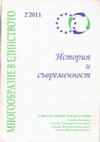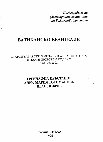Papers by Трендафил Кръстанов

История и съвременност, Многообразие в единството, 2011-02, Съюз на учените в България, 2011
Primas „на словенски или български или славянски” е прэболии - „най-пръв” според испанска канонич... more Primas „на словенски или български или славянски” е прэболии - „най-пръв” според испанска каноническа бележка от XII век за архиепископията на България.
The Title primas in Nota sobre arcibistopado de Bolgaria from 12th century is definied as protos or “prebol” ПРЭБОЛИИ in Slavonian or Bulgarian or Slavic Language. This Word is hapax in the Oldbulgarian Language in the Translations of the great Bulgarian man of letter and Christian clergyman John Exarch - archbishop and patriarch of the Bulgarian Lands (mid 9th c. – beg. 10th c.), not only in his Sestodnev, but also in the 40 Homilies to pope Gregorios the Great. This Fact is a new Argument to the Authorship of the Translation from Latin to the 40 Homilies in to native Vernicular to John Exarch of Bulgaria – Slavonian or Bulgarian or Slavic Language, the same Language to the Translations of the slavonian Teachers Cyril and Methodius (Vondrac 1896, p.19).
Славянски палимсест в Cod. Vat. Gr. 2502. Парадокси на Кирило-Методиевската мисия, итало-българска следа и аксиома на езика, 2013
Books by Трендафил Кръстанов

Ватиканско евангелие. Старобългарски кирилски апракос от Х в палимпсестен кодекс Vat. Gr. 2502, 1996
VATICAN GOSPEL
Old Bulgarian Cyrillic 10th Century Aprakos
in Palimpsest Codex Vat.Gr.2502
In ... more VATICAN GOSPEL
Old Bulgarian Cyrillic 10th Century Aprakos
in Palimpsest Codex Vat.Gr.2502
In the Vatican Apostolic Library, under press-mark Vat. Gr. 2502, a Greek Gospel of the 12th-13th Century has been kept. It is a palimpsest, i.e. it was written on a parchment already used, on which the Greek minuscule letters (diminutive and attached one to the other) were laid on a precious Old Bulgarian Cyrillic manuscript of the 10th Century and they had partially covered it up. Fragments of the initial text can be seen in the interlines of the second layer and they could be read out. It was established that Codex Vaticanus Graecus 2502 contains the Old Bulgarian translation of one of the most widespreadly used books - the Gospel Lectionary (Asprakos). That translation from Greek appeared in year 862, already at the dawn of the Slavonic literature (The Detailed Life of St. Cyril, Chapter 14) and it had been widely used in the old Bulgarian Church.
For a long period of time, nothing was known about the Old Bulgarian manuscript, hidden under the more recent Greek letters. The first notices of it appeared in 1982, in the Scientific report by T.Krastanov, named "Неизвестен старобългарски ръкопис- палимпсест, вероятно от 11 век, във Ватиканската библиотека" , Духовна култура, LXII, 1982, 7 ("Unknown Old Bulgarian Manuscript-Palimpsest, probably from the 10th Century, in the Vatican Library", - Spiritual Culture, LXII, 1982, 7). At a greater length, the Old Bulgarian text Cod.Vat.Gr.2502 was presen-
ted in the composed by A.Dzurova, K.Stancev and M.Yapundzic "Catalogo dei manoscritti slavi della Biblioteca Vaticana" (Sofia, 1985, pp. 186-201, with three pictures in the Annex, the last two of which are colour pictures), as well as in the article of T.Krastanov, named "Български ватикански палимпсест в Cod.Vat.Gr. 2502", published in Palaeobulgarica, XII, 1988, 1, pp. 38-66. This article contains 6 pages of deciphered text and illustrations.
The offered edition is an attempt to reproduce and bring to the knowledge of the Slavonic Studies what has been preserved from the Old Bulgarian Aprakos at Vatican which is a coherent text and that could be deciphered. The visible text has been given by bigger letters while the content of the deciphered text has been reproduced by smaller letters. By k have been marked the еръ/еръ in the cases when it could not be read out if it were ъ or ь,, and by A, the nasal sound в when it could not be made out whether it was A, A, A or A. The fullstop has been marked by • when it or the interval where it was supposed to be put, could be seen.
The initial deciphering of the text was made by T. Krastanov. His version was checked, corrected and supplemented by I.Dobrev, on the basis of photocopies. The final and improved edition of the text belongs to A.-M.Totomanova who, in her many visits to the Vatican Library, was able to work longer than T.Krastanov with the original, and by means of infrared lamp to supplement the already deciphered text and to offer her own hypothesis about the order of the leaves in the Old Bulgarian original. That hypothesis was taken account of in the edition. A.-M.Totomanova also made the last corrections upon the editorial project of I.Dobrev.










Uploads
Papers by Трендафил Кръстанов
The Title primas in Nota sobre arcibistopado de Bolgaria from 12th century is definied as protos or “prebol” ПРЭБОЛИИ in Slavonian or Bulgarian or Slavic Language. This Word is hapax in the Oldbulgarian Language in the Translations of the great Bulgarian man of letter and Christian clergyman John Exarch - archbishop and patriarch of the Bulgarian Lands (mid 9th c. – beg. 10th c.), not only in his Sestodnev, but also in the 40 Homilies to pope Gregorios the Great. This Fact is a new Argument to the Authorship of the Translation from Latin to the 40 Homilies in to native Vernicular to John Exarch of Bulgaria – Slavonian or Bulgarian or Slavic Language, the same Language to the Translations of the slavonian Teachers Cyril and Methodius (Vondrac 1896, p.19).
Books by Трендафил Кръстанов
Old Bulgarian Cyrillic 10th Century Aprakos
in Palimpsest Codex Vat.Gr.2502
In the Vatican Apostolic Library, under press-mark Vat. Gr. 2502, a Greek Gospel of the 12th-13th Century has been kept. It is a palimpsest, i.e. it was written on a parchment already used, on which the Greek minuscule letters (diminutive and attached one to the other) were laid on a precious Old Bulgarian Cyrillic manuscript of the 10th Century and they had partially covered it up. Fragments of the initial text can be seen in the interlines of the second layer and they could be read out. It was established that Codex Vaticanus Graecus 2502 contains the Old Bulgarian translation of one of the most widespreadly used books - the Gospel Lectionary (Asprakos). That translation from Greek appeared in year 862, already at the dawn of the Slavonic literature (The Detailed Life of St. Cyril, Chapter 14) and it had been widely used in the old Bulgarian Church.
For a long period of time, nothing was known about the Old Bulgarian manuscript, hidden under the more recent Greek letters. The first notices of it appeared in 1982, in the Scientific report by T.Krastanov, named "Неизвестен старобългарски ръкопис- палимпсест, вероятно от 11 век, във Ватиканската библиотека" , Духовна култура, LXII, 1982, 7 ("Unknown Old Bulgarian Manuscript-Palimpsest, probably from the 10th Century, in the Vatican Library", - Spiritual Culture, LXII, 1982, 7). At a greater length, the Old Bulgarian text Cod.Vat.Gr.2502 was presen-
ted in the composed by A.Dzurova, K.Stancev and M.Yapundzic "Catalogo dei manoscritti slavi della Biblioteca Vaticana" (Sofia, 1985, pp. 186-201, with three pictures in the Annex, the last two of which are colour pictures), as well as in the article of T.Krastanov, named "Български ватикански палимпсест в Cod.Vat.Gr. 2502", published in Palaeobulgarica, XII, 1988, 1, pp. 38-66. This article contains 6 pages of deciphered text and illustrations.
The offered edition is an attempt to reproduce and bring to the knowledge of the Slavonic Studies what has been preserved from the Old Bulgarian Aprakos at Vatican which is a coherent text and that could be deciphered. The visible text has been given by bigger letters while the content of the deciphered text has been reproduced by smaller letters. By k have been marked the еръ/еръ in the cases when it could not be read out if it were ъ or ь,, and by A, the nasal sound в when it could not be made out whether it was A, A, A or A. The fullstop has been marked by • when it or the interval where it was supposed to be put, could be seen.
The initial deciphering of the text was made by T. Krastanov. His version was checked, corrected and supplemented by I.Dobrev, on the basis of photocopies. The final and improved edition of the text belongs to A.-M.Totomanova who, in her many visits to the Vatican Library, was able to work longer than T.Krastanov with the original, and by means of infrared lamp to supplement the already deciphered text and to offer her own hypothesis about the order of the leaves in the Old Bulgarian original. That hypothesis was taken account of in the edition. A.-M.Totomanova also made the last corrections upon the editorial project of I.Dobrev.
The Title primas in Nota sobre arcibistopado de Bolgaria from 12th century is definied as protos or “prebol” ПРЭБОЛИИ in Slavonian or Bulgarian or Slavic Language. This Word is hapax in the Oldbulgarian Language in the Translations of the great Bulgarian man of letter and Christian clergyman John Exarch - archbishop and patriarch of the Bulgarian Lands (mid 9th c. – beg. 10th c.), not only in his Sestodnev, but also in the 40 Homilies to pope Gregorios the Great. This Fact is a new Argument to the Authorship of the Translation from Latin to the 40 Homilies in to native Vernicular to John Exarch of Bulgaria – Slavonian or Bulgarian or Slavic Language, the same Language to the Translations of the slavonian Teachers Cyril and Methodius (Vondrac 1896, p.19).
Old Bulgarian Cyrillic 10th Century Aprakos
in Palimpsest Codex Vat.Gr.2502
In the Vatican Apostolic Library, under press-mark Vat. Gr. 2502, a Greek Gospel of the 12th-13th Century has been kept. It is a palimpsest, i.e. it was written on a parchment already used, on which the Greek minuscule letters (diminutive and attached one to the other) were laid on a precious Old Bulgarian Cyrillic manuscript of the 10th Century and they had partially covered it up. Fragments of the initial text can be seen in the interlines of the second layer and they could be read out. It was established that Codex Vaticanus Graecus 2502 contains the Old Bulgarian translation of one of the most widespreadly used books - the Gospel Lectionary (Asprakos). That translation from Greek appeared in year 862, already at the dawn of the Slavonic literature (The Detailed Life of St. Cyril, Chapter 14) and it had been widely used in the old Bulgarian Church.
For a long period of time, nothing was known about the Old Bulgarian manuscript, hidden under the more recent Greek letters. The first notices of it appeared in 1982, in the Scientific report by T.Krastanov, named "Неизвестен старобългарски ръкопис- палимпсест, вероятно от 11 век, във Ватиканската библиотека" , Духовна култура, LXII, 1982, 7 ("Unknown Old Bulgarian Manuscript-Palimpsest, probably from the 10th Century, in the Vatican Library", - Spiritual Culture, LXII, 1982, 7). At a greater length, the Old Bulgarian text Cod.Vat.Gr.2502 was presen-
ted in the composed by A.Dzurova, K.Stancev and M.Yapundzic "Catalogo dei manoscritti slavi della Biblioteca Vaticana" (Sofia, 1985, pp. 186-201, with three pictures in the Annex, the last two of which are colour pictures), as well as in the article of T.Krastanov, named "Български ватикански палимпсест в Cod.Vat.Gr. 2502", published in Palaeobulgarica, XII, 1988, 1, pp. 38-66. This article contains 6 pages of deciphered text and illustrations.
The offered edition is an attempt to reproduce and bring to the knowledge of the Slavonic Studies what has been preserved from the Old Bulgarian Aprakos at Vatican which is a coherent text and that could be deciphered. The visible text has been given by bigger letters while the content of the deciphered text has been reproduced by smaller letters. By k have been marked the еръ/еръ in the cases when it could not be read out if it were ъ or ь,, and by A, the nasal sound в when it could not be made out whether it was A, A, A or A. The fullstop has been marked by • when it or the interval where it was supposed to be put, could be seen.
The initial deciphering of the text was made by T. Krastanov. His version was checked, corrected and supplemented by I.Dobrev, on the basis of photocopies. The final and improved edition of the text belongs to A.-M.Totomanova who, in her many visits to the Vatican Library, was able to work longer than T.Krastanov with the original, and by means of infrared lamp to supplement the already deciphered text and to offer her own hypothesis about the order of the leaves in the Old Bulgarian original. That hypothesis was taken account of in the edition. A.-M.Totomanova also made the last corrections upon the editorial project of I.Dobrev.